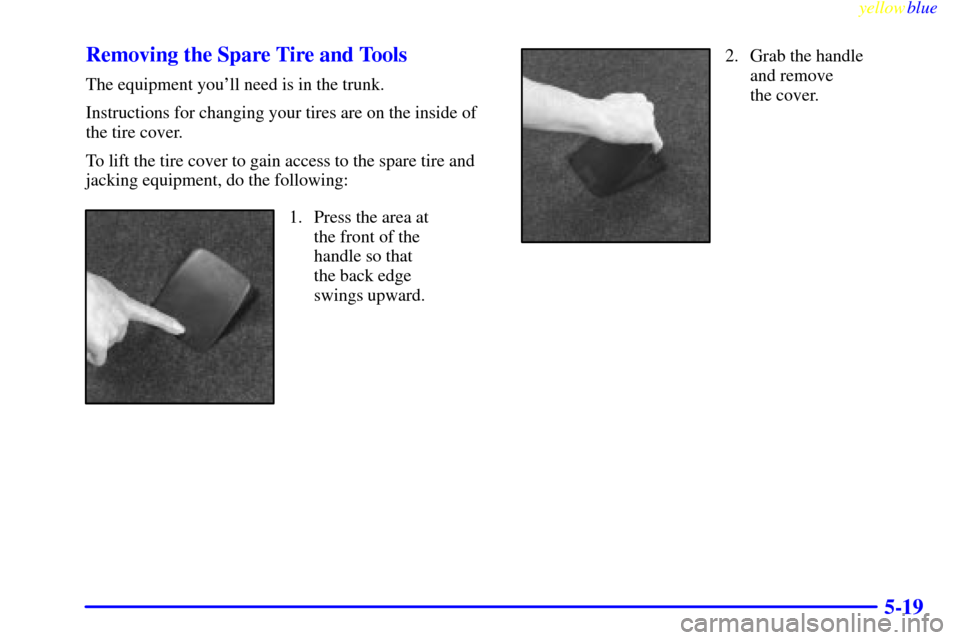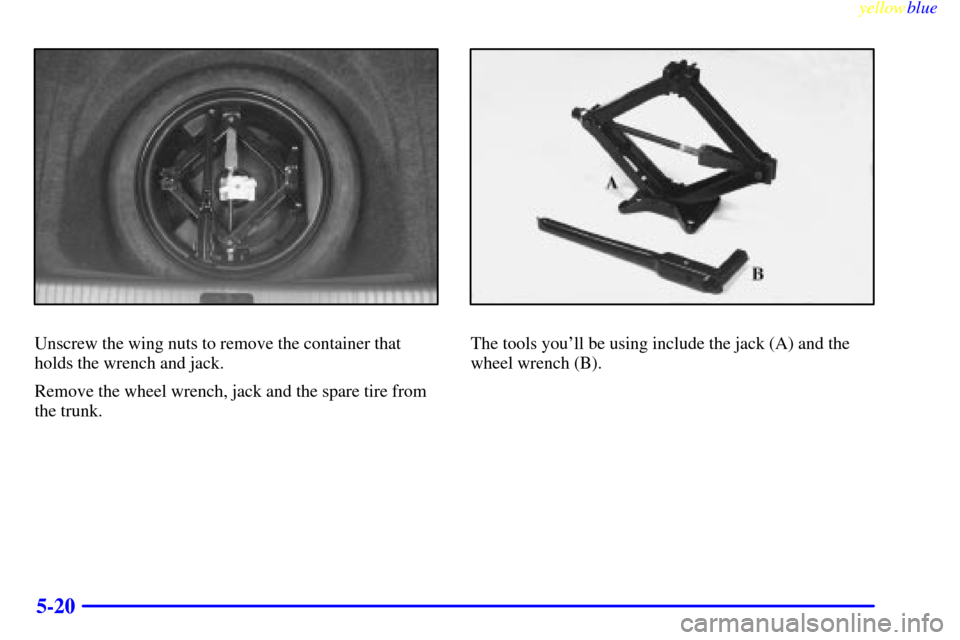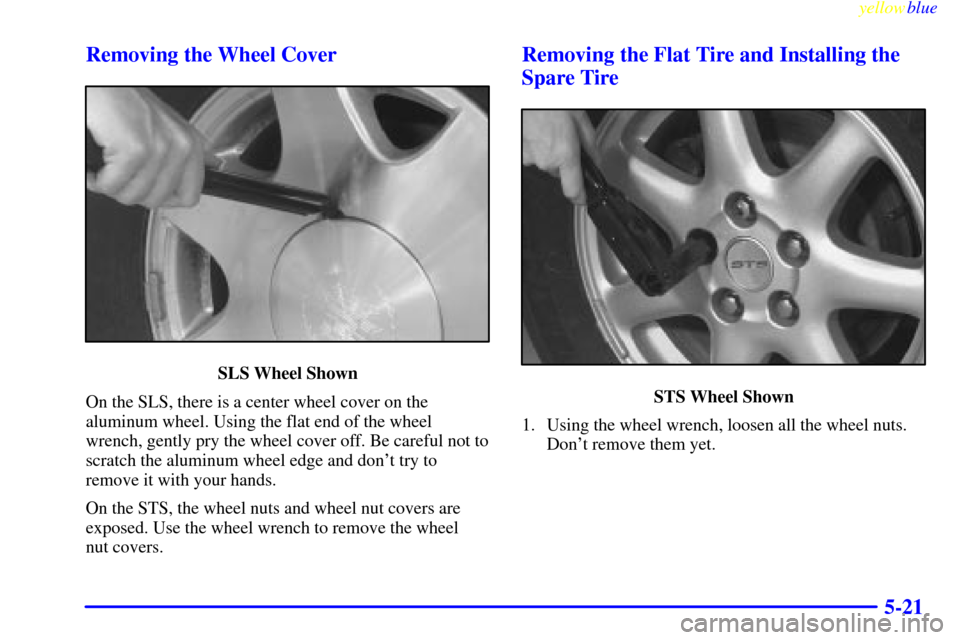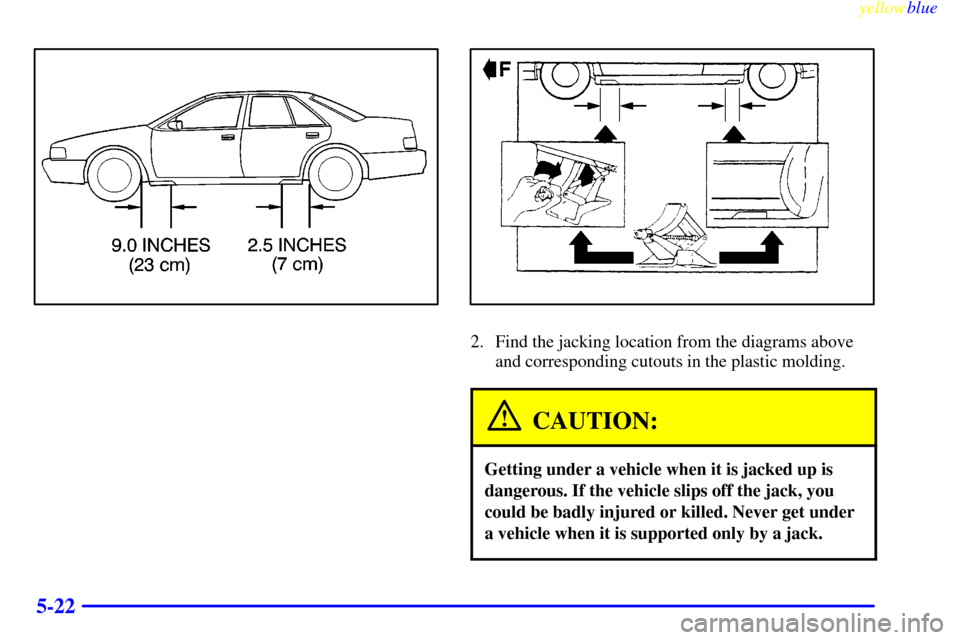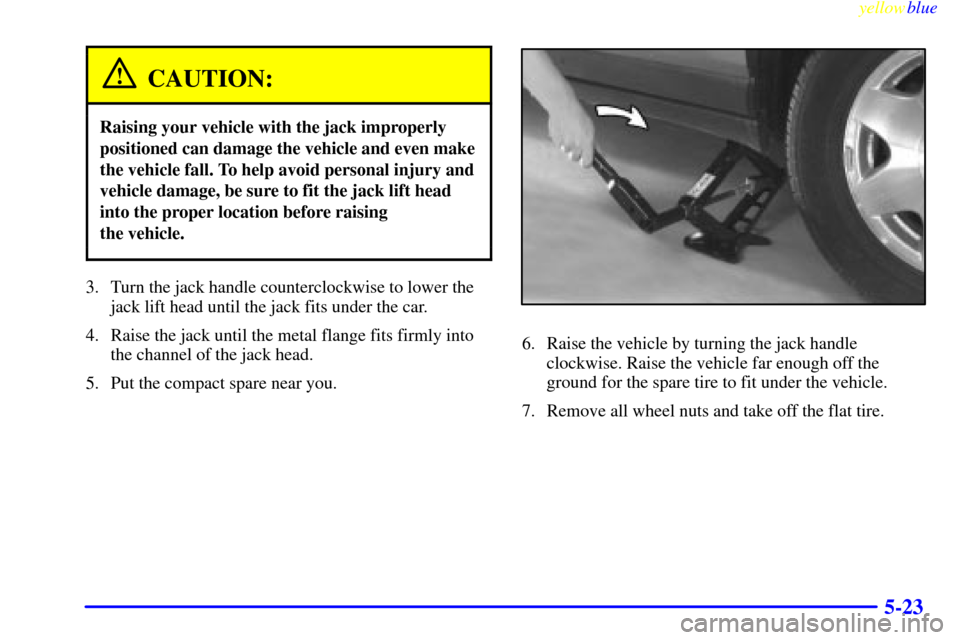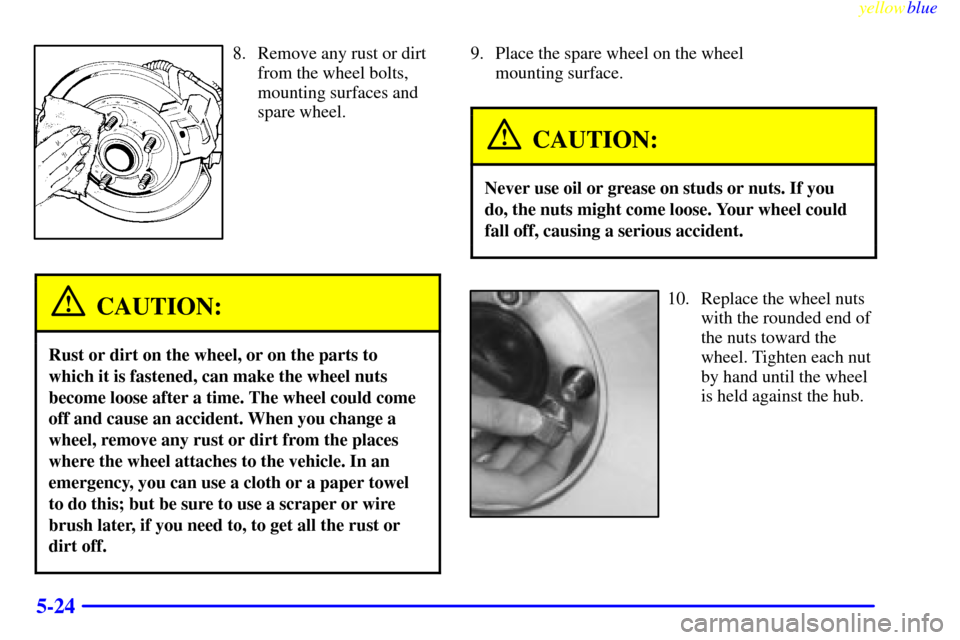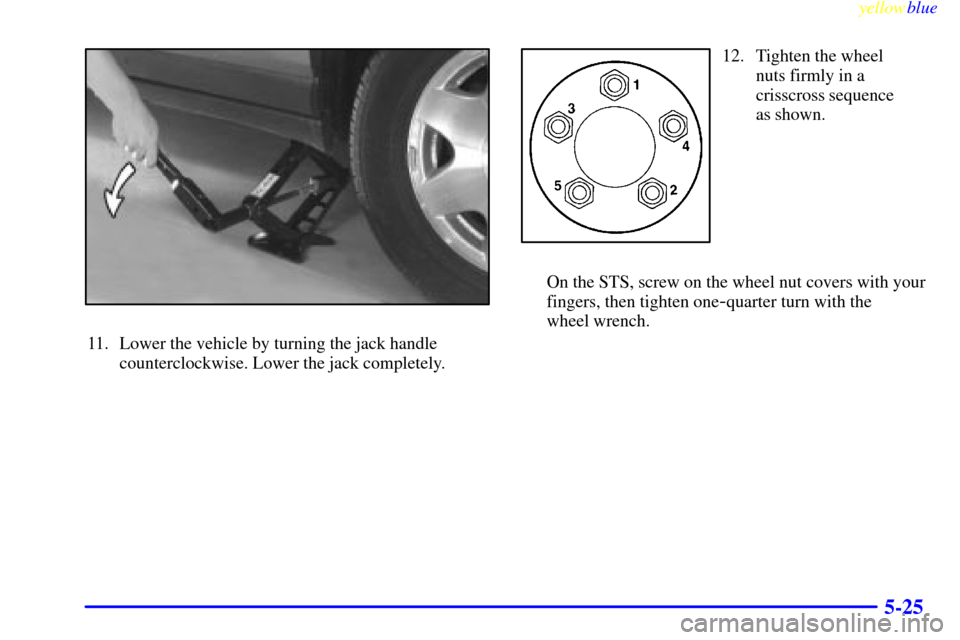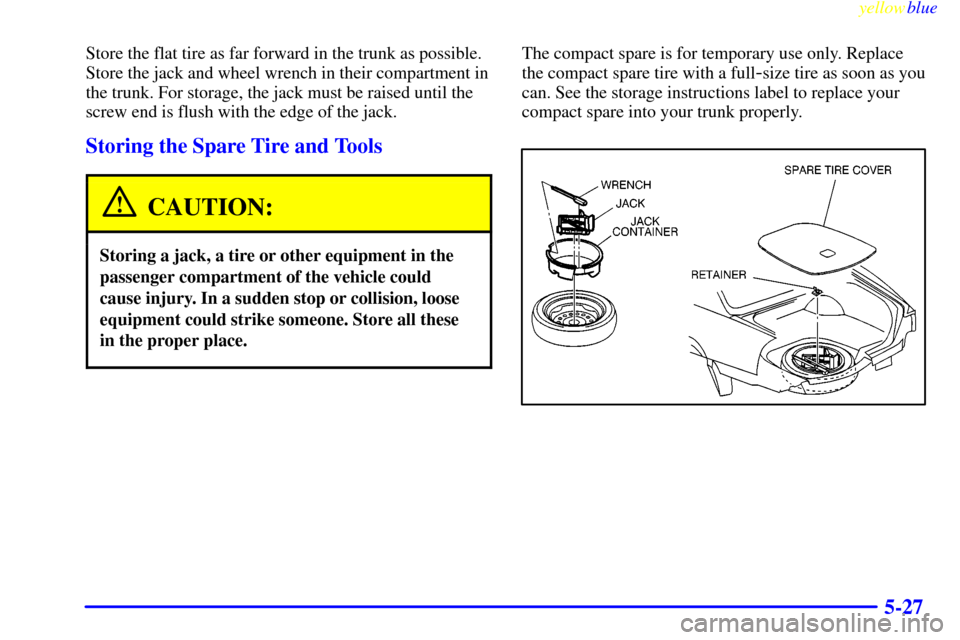CADILLAC SEVILLE 1999 5.G Owners Manual
SEVILLE 1999 5.G
CADILLAC
CADILLAC
https://www.carmanualsonline.info/img/23/7941/w960_7941-0.png
CADILLAC SEVILLE 1999 5.G Owners Manual
Trending: interior lights, hood release, refrigerant type, wheel alignment, service schedule, child lock, spare wheel
Page 251 of 362
yellowblue
5-19 Removing the Spare Tire and Tools
The equipment you'll need is in the trunk.
Instructions for changing your tires are on the inside of
the tire cover.
To lift the tire cover to gain access to the spare tire and
jacking equipment, do the following:
1. Press the area at
the front of the
handle so that
the back edge
swings upward.
2. Grab the handle
and remove
the cover.
Page 252 of 362
yellowblue
5-20
Unscrew the wing nuts to remove the container that
holds the wrench and jack.
Remove the wheel wrench, jack and the spare tire from
the trunk.The tools you'll be using include the jack (A) and the
wheel wrench (B).
Page 253 of 362
yellowblue
5-21 Removing the Wheel Cover
SLS Wheel Shown
On the SLS, there is a center wheel cover on the
aluminum wheel. Using the flat end of the wheel
wrench, gently pry the wheel cover off. Be careful not to
scratch the aluminum wheel edge and don't try to
remove it with your hands.
On the STS, the wheel nuts and wheel nut covers are
exposed. Use the wheel wrench to remove the wheel
nut covers.
Removing the Flat Tire and Installing the
Spare Tire
STS Wheel Shown
1. Using the wheel wrench, loosen all the wheel nuts.
Don't remove them yet.
Page 254 of 362
yellowblue
5-22
2. Find the jacking location from the diagrams above
and corresponding cutouts in the plastic molding.
CAUTION:
Getting under a vehicle when it is jacked up is
dangerous. If the vehicle slips off the jack, you
could be badly injured or killed. Never get under
a vehicle when it is supported only by a jack.
Page 255 of 362
yellowblue
5-23
CAUTION:
Raising your vehicle with the jack improperly
positioned can damage the vehicle and even make
the vehicle fall. To help avoid personal injury and
vehicle damage, be sure to fit the jack lift head
into the proper location before raising
the vehicle.
3. Turn the jack handle counterclockwise to lower the
jack lift head until the jack fits under the car.
4. Raise the jack until the metal flange fits firmly into
the channel of the jack head.
5. Put the compact spare near you.
6. Raise the vehicle by turning the jack handle
clockwise. Raise the vehicle far enough off the
ground for the spare tire to fit under the vehicle.
7. Remove all wheel nuts and take off the flat tire.
Page 256 of 362
yellowblue
5-24
8. Remove any rust or dirt
from the wheel bolts,
mounting surfaces and
spare wheel.
CAUTION:
Rust or dirt on the wheel, or on the parts to
which it is fastened, can make the wheel nuts
become loose after a time. The wheel could come
off and cause an accident. When you change a
wheel, remove any rust or dirt from the places
where the wheel attaches to the vehicle. In an
emergency, you can use a cloth or a paper towel
to do this; but be sure to use a scraper or wire
brush later, if you need to, to get all the rust or
dirt off.
9. Place the spare wheel on the wheel
mounting surface.
CAUTION:
Never use oil or grease on studs or nuts. If you
do, the nuts might come loose. Your wheel could
fall off, causing a serious accident.
10. Replace the wheel nuts
with the rounded end of
the nuts toward the
wheel. Tighten each nut
by hand until the wheel
is held against the hub.
Page 257 of 362
yellowblue
5-25
11. Lower the vehicle by turning the jack handle
counterclockwise. Lower the jack completely.
12. Tighten the wheel
nuts firmly in a
crisscross sequence
as shown.
On the STS, screw on the wheel nut covers with your
fingers, then tighten one
-quarter turn with the
wheel wrench.
Page 258 of 362
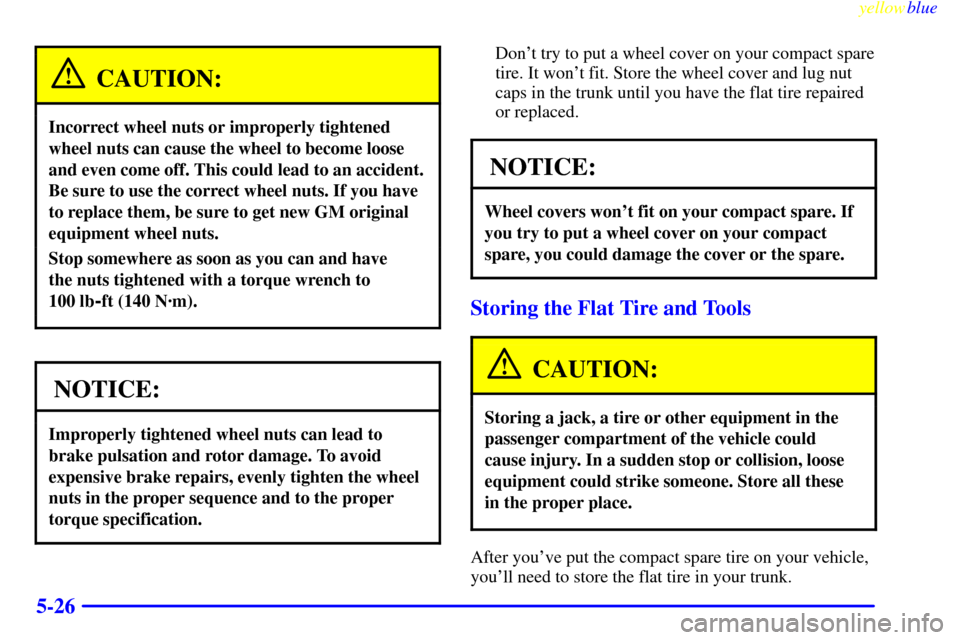
yellowblue
5-26
CAUTION:
Incorrect wheel nuts or improperly tightened
wheel nuts can cause the wheel to become loose
and even come off. This could lead to an accident.
Be sure to use the correct wheel nuts. If you have
to replace them, be sure to get new GM original
equipment wheel nuts.
Stop somewhere as soon as you can and have
the nuts tightened with a torque wrench to
100 lb
-ft (140 N´m).
NOTICE:
Improperly tightened wheel nuts can lead to
brake pulsation and rotor damage. To avoid
expensive brake repairs, evenly tighten the wheel
nuts in the proper sequence and to the proper
torque specification.
Don't try to put a wheel cover on your compact spare
tire. It won't fit. Store the wheel cover and lug nut
caps in the trunk until you have the flat tire repaired
or replaced.
NOTICE:
Wheel covers won't fit on your compact spare. If
you try to put a wheel cover on your compact
spare, you could damage the cover or the spare.
Storing the Flat Tire and Tools
CAUTION:
Storing a jack, a tire or other equipment in the
passenger compartment of the vehicle could
cause injury. In a sudden stop or collision, loose
equipment could strike someone. Store all these
in the proper place.
After you've put the compact spare tire on your vehicle,
you'll need to store the flat tire in your trunk.
Page 259 of 362
yellowblue
5-27
Store the flat tire as far forward in the trunk as possible.
Store the jack and wheel wrench in their compartment in
the trunk. For storage, the jack must be raised until the
screw end is flush with the edge of the jack.
Storing the Spare Tire and Tools
CAUTION:
Storing a jack, a tire or other equipment in the
passenger compartment of the vehicle could
cause injury. In a sudden stop or collision, loose
equipment could strike someone. Store all these
in the proper place.
The compact spare is for temporary use only. Replace
the compact spare tire with a full
-size tire as soon as you
can. See the storage instructions label to replace your
compact spare into your trunk properly.
Page 260 of 362
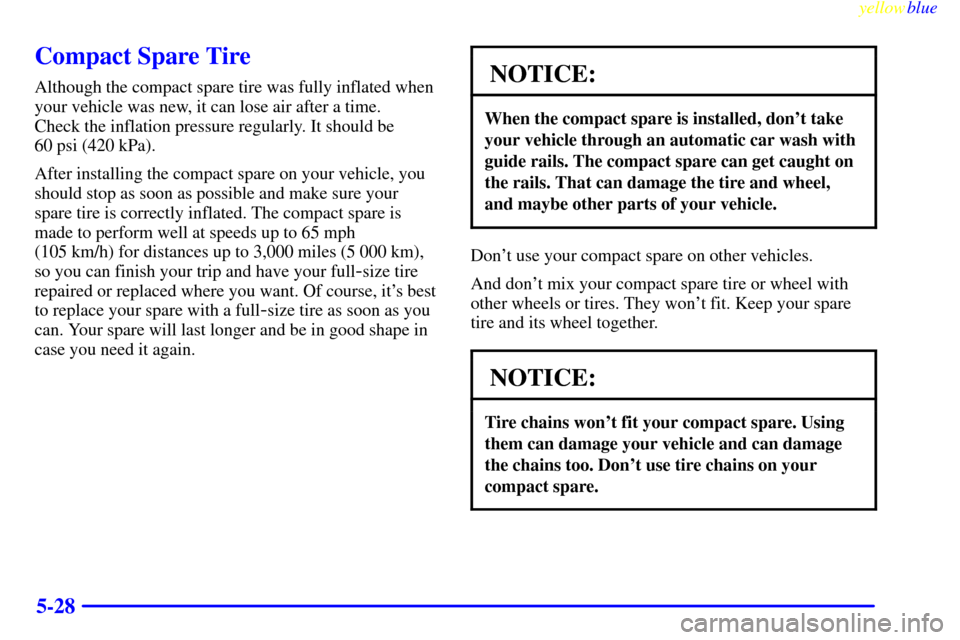
yellowblue
5-28
Compact Spare Tire
Although the compact spare tire was fully inflated when
your vehicle was new, it can lose air after a time.
Check the inflation pressure regularly. It should be
60 psi (420 kPa).
After installing the compact spare on your vehicle, you
should stop as soon as possible and make sure your
spare tire is correctly inflated. The compact spare is
made to perform well at speeds up to 65 mph
(105 km/h) for distances up to 3,000 miles (5 000 km),
so you can finish your trip and have your full
-size tire
repaired or replaced where you want. Of course, it's best
to replace your spare with a full
-size tire as soon as you
can. Your spare will last longer and be in good shape in
case you need it again.
NOTICE:
When the compact spare is installed, don't take
your vehicle through an automatic car wash with
guide rails. The compact spare can get caught on
the rails. That can damage the tire and wheel,
and maybe other parts of your vehicle.
Don't use your compact spare on other vehicles.
And don't mix your compact spare tire or wheel with
other wheels or tires. They won't fit. Keep your spare
tire and its wheel together.
NOTICE:
Tire chains won't fit your compact spare. Using
them can damage your vehicle and can damage
the chains too. Don't use tire chains on your
compact spare.
Trending: diagram, set clock, engine overheat, radio antenna, oil, ad blue, change language
